air condition CHEVROLET ASTRO PASSENGER 1994 1.G Owners Manual
[x] Cancel search | Manufacturer: CHEVROLET, Model Year: 1994, Model line: ASTRO PASSENGER, Model: CHEVROLET ASTRO PASSENGER 1994 1.GPages: 340, PDF Size: 16.86 MB
Page 112 of 340
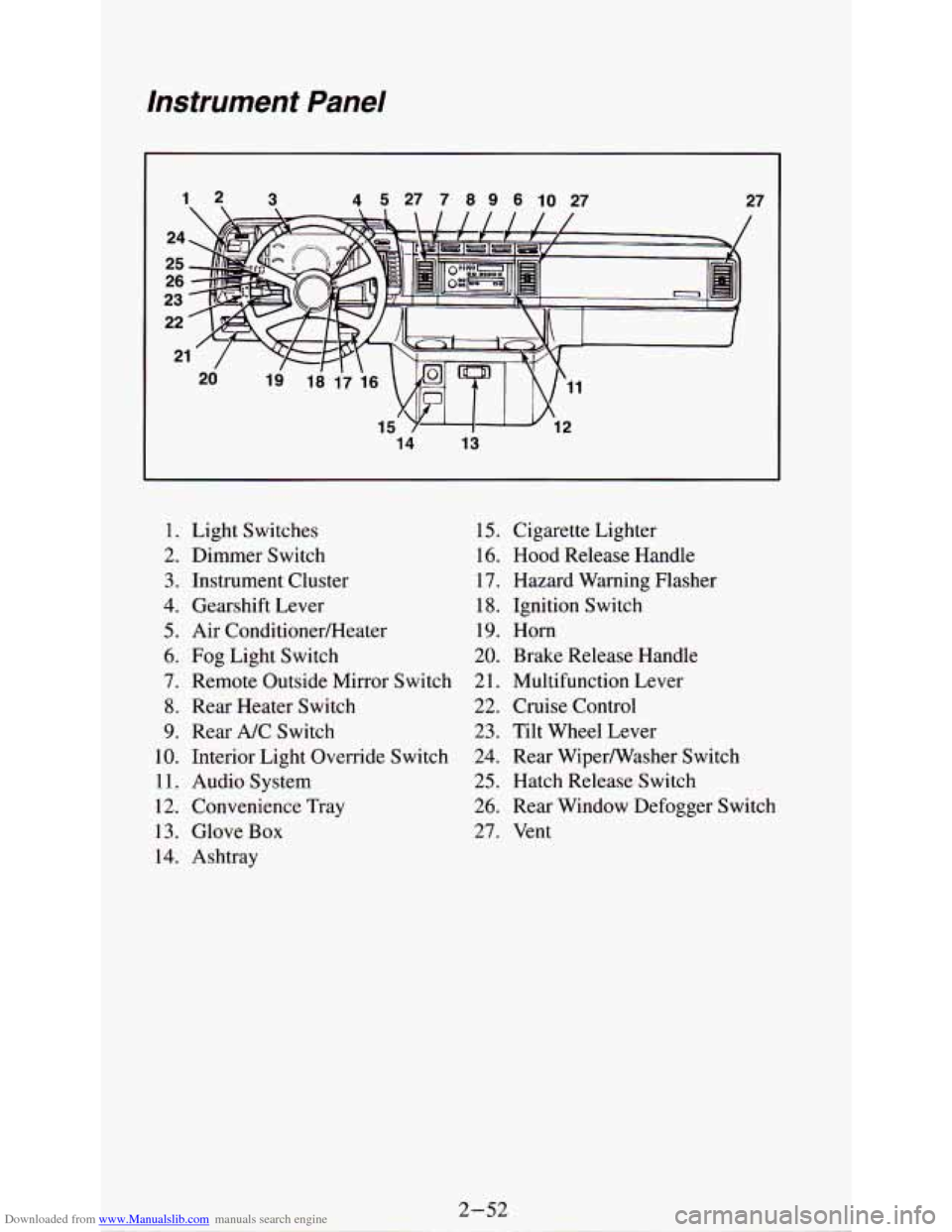
Downloaded from www.Manualslib.com manuals search engine Instrument Panel
14 13
27
/
1. Light Switches
2. Dimmer Switch
3. Instrument Cluster
4. Gearshift Lever
5. Air ConditionedHeater
6. Fog Light Switch
7. Remote Outside Mirror Switch
8. Rear Heater Switch
9. Rear A/C Switch
10. Interior Light Override Switch
11. Audio System
12. Convenience Tray
13. Glove
Box
14. Ashtray
15. Cigarette Lighter
16.
Hood Release Handle
17. Hazard Warning Flasher
18. Ignition Switch
19. Horn
20. Brake Release Handle
2
1. Multifunction Lever
22. Cruise Control
23. Tilt Wheel Lever
24. Rear Wipermasher Switch
25. Hatch Release Switch
26. Rear Window Defogger Switch
27. Vent
Page 119 of 340
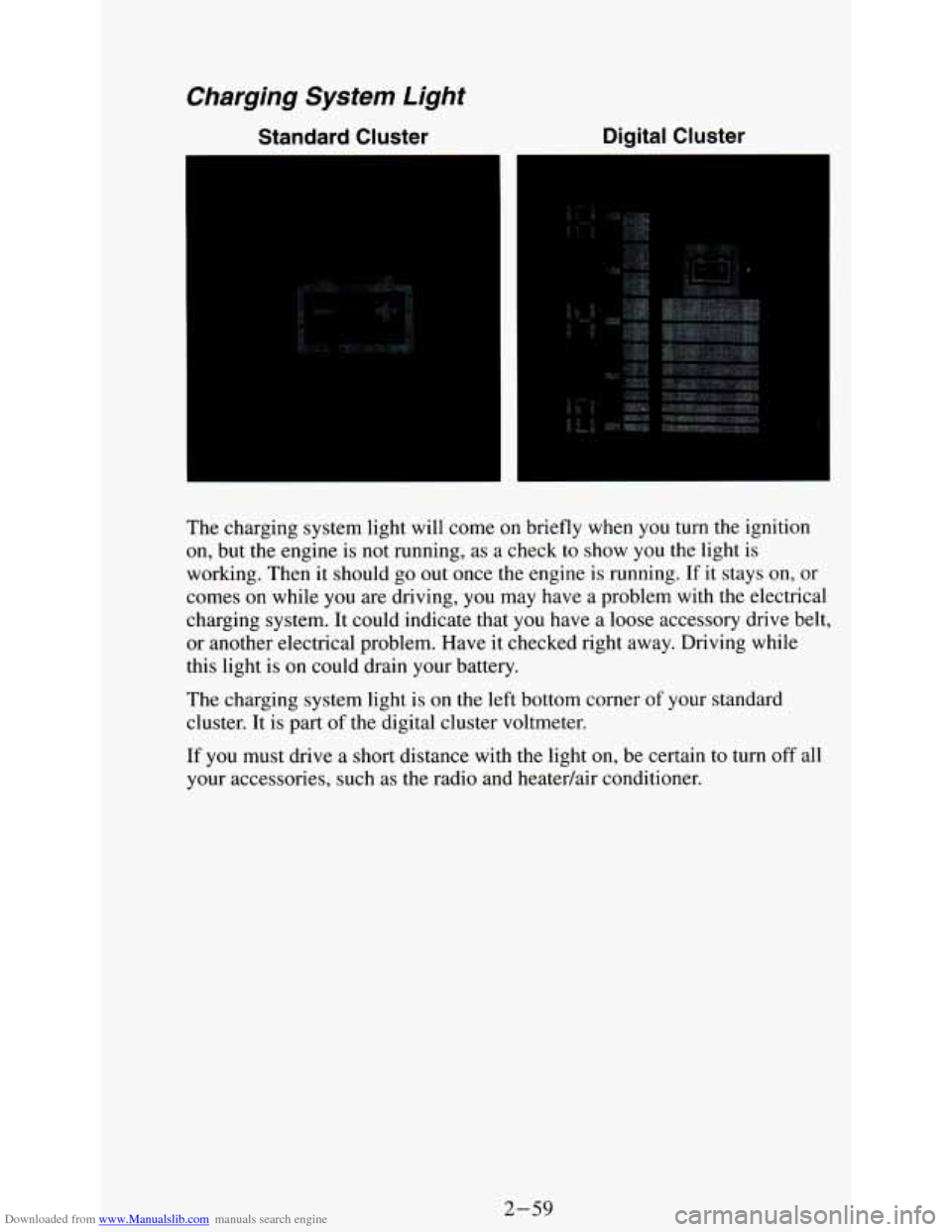
Downloaded from www.Manualslib.com manuals search engine The charging system light will come on briefly when you turn the ignition
on, but the engine is not running, as a check to show you the light is
working. Then
it should go out once the engine is running. If it stays on, or
comes on while you are driving, you may have a problem with the electrical
charging system. It could indicate that you have a loose accessory drive belt,
or another electrical problem. Have it checked right away. Driving while
this light
is on could drain your battery.
The charging system light is on the left bottom corner of your standard
cluster. It is part
of the digital cluster voltmeter.
If you must drive a short distance with the light on, be certain to turn off all
your accessories, such as the radio and heatedair conditioner.
2-59
Page 129 of 340
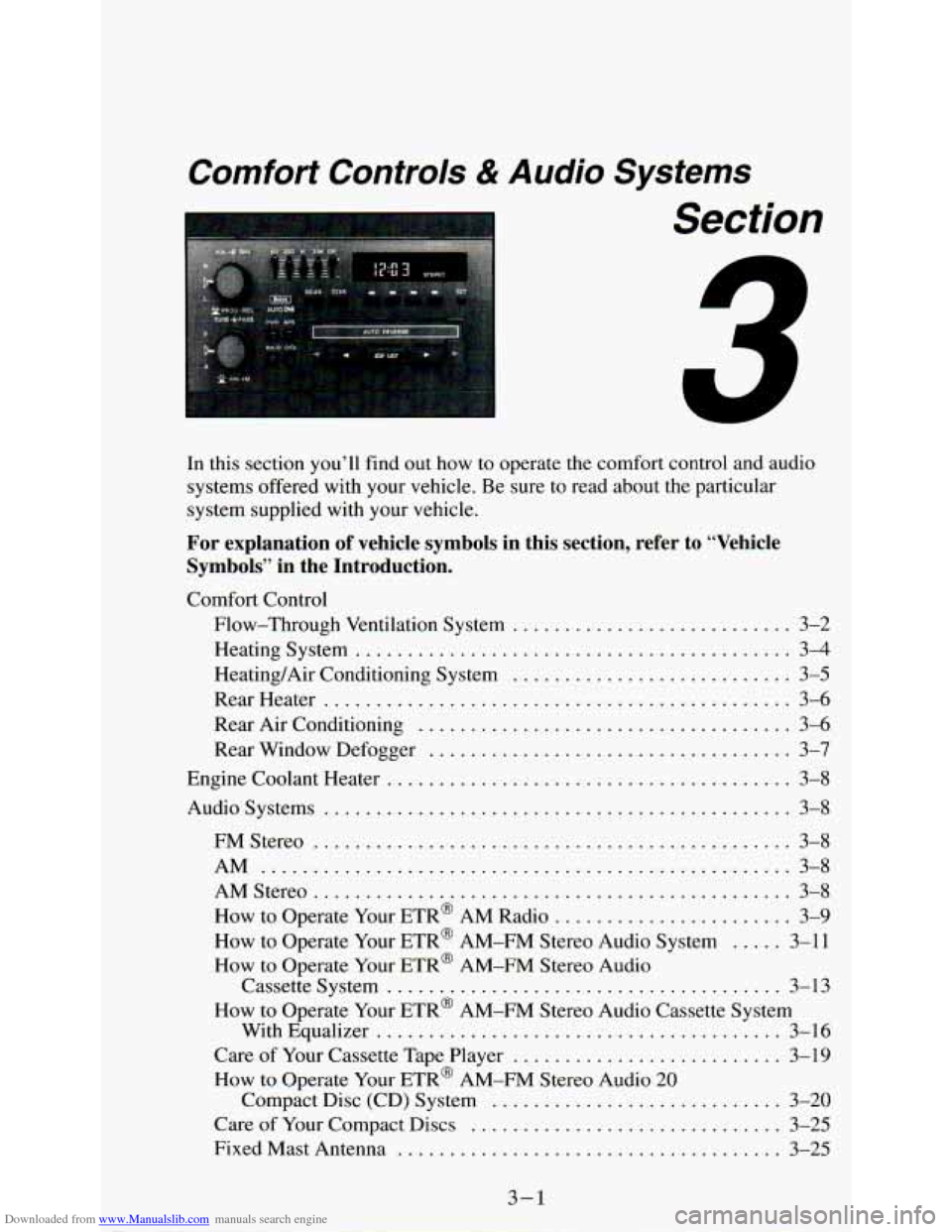
Downloaded from www.Manualslib.com manuals search engine Comfort Controls & Audio Systems
Section
In this section you’ll find out how to operate the comfort control and audio
systems offered with your vehicle
. Be sure to read about the particular
system supplied with your vehicle
.
For explanation of vehicle symbols in this section. refer to “Vehicle
Symbols” in the Introduction
.
Comfort Control
Flow-Through Ventilation System
......................... 3-2
Heating System
........................................ 3-4
Heating/Air Conditioning System
........................... 3-5
RearHeater
............................................. 3-6
Rear Air Conditioning
......................... ..... 3-6
Rear Window Defogger
. . .......... ... 3-7
Engine Coolant Heater
.............................. ..... 3-8
Audiosystems
............................................. 3-8
....... ....... ........... FM Stereo . . ..... 3-8
AMStereo
.............................................. 3-8
How to Operate Your ETR@ AM Radio
....................... 3-9
How to Operate Your ETR@ AM-FM Stereo Audio System
... 3-11
How to Operate Your ETR@ AM-FM Stereo Audio
Cassette System
...................................... 3-13
How to Operate Your ETR@ AM-FM Stereo Audio Cassette System
With Equalizer
....................................... 3-16
Care of Your Cassette Tape Player
.......................... 3-19
How to Operate Your ETR@ AM-FM Stereo Audio 20
Compact Disc (CD) System
............................ 3-20
Care
of Your Compact Discs .............................. 3-25
Fixed Mast Antenna
..................................... 3-25
AM
............................................. 3-8
3-1
Page 130 of 340
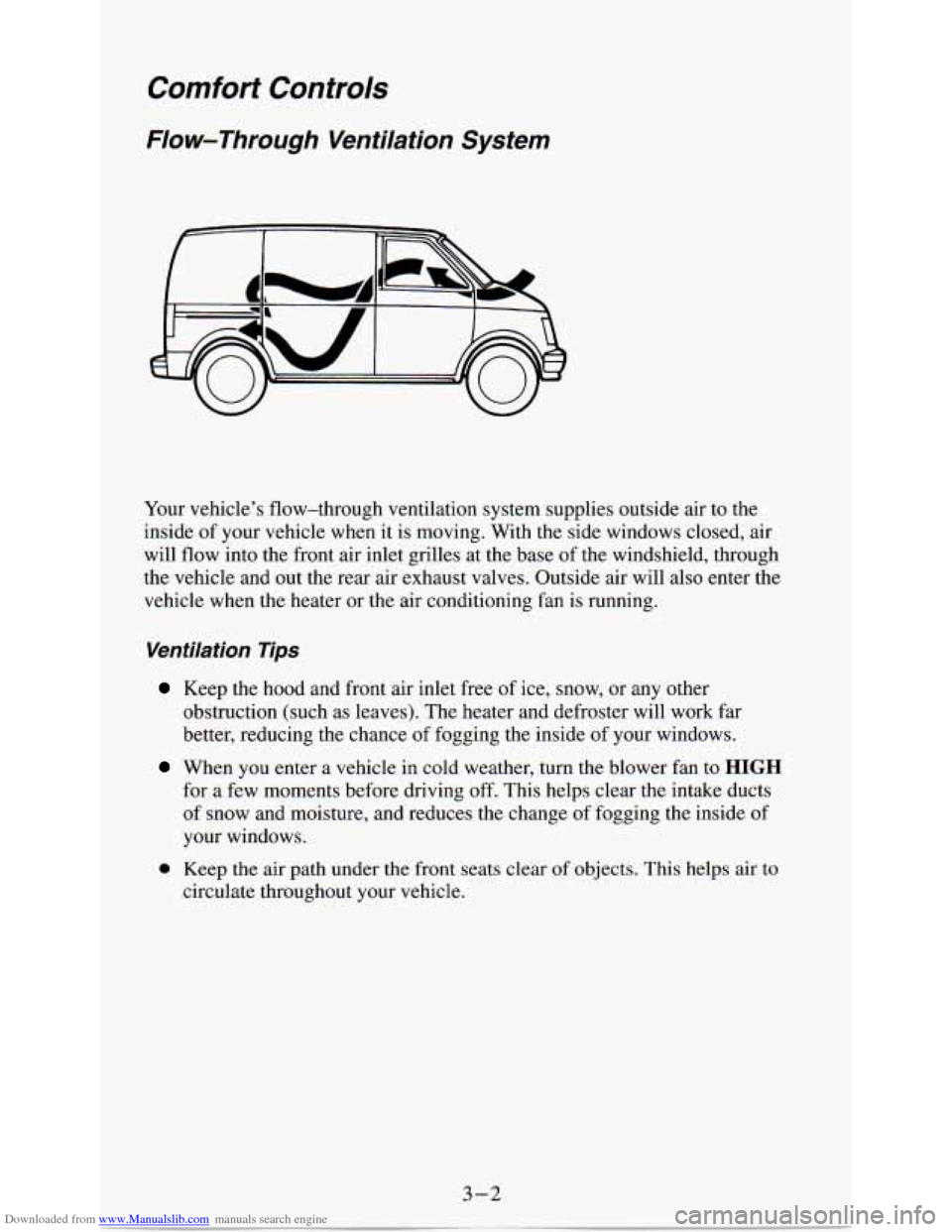
Downloaded from www.Manualslib.com manuals search engine Comfort Controk
Flow-Through Ventilation System
W W
Your vehicle’s flow-through ventilation system supplies outside air to the
inside
of your vehicle when it is moving. With the side windows closed, air
will flow into the front air inlet grilles at the base of the windshield, through
the vehicle and out the rear air exhaust valves. Outside air will also enter the
vehicle when the heater or the air conditioning fan is running.
Ventilation Tips
Keep the hood and front air inlet free of ice, snow, or any other
obstruction (such as leaves). The heater and defroster will work far
better, reducing the chance
of fogging the inside of your windows.
When you enter a vehicle in cold weather, turn the blower fan\
to HIGH
for a few moments before driving off. This helps clear the intake ducts
of snow and moisture, and reduces the change
of fogging the inside of
your windows.
0 Keep the air path under the front seats clear of objects. This helps air to
circulate throughout your vehicle.
3-2
Page 131 of 340
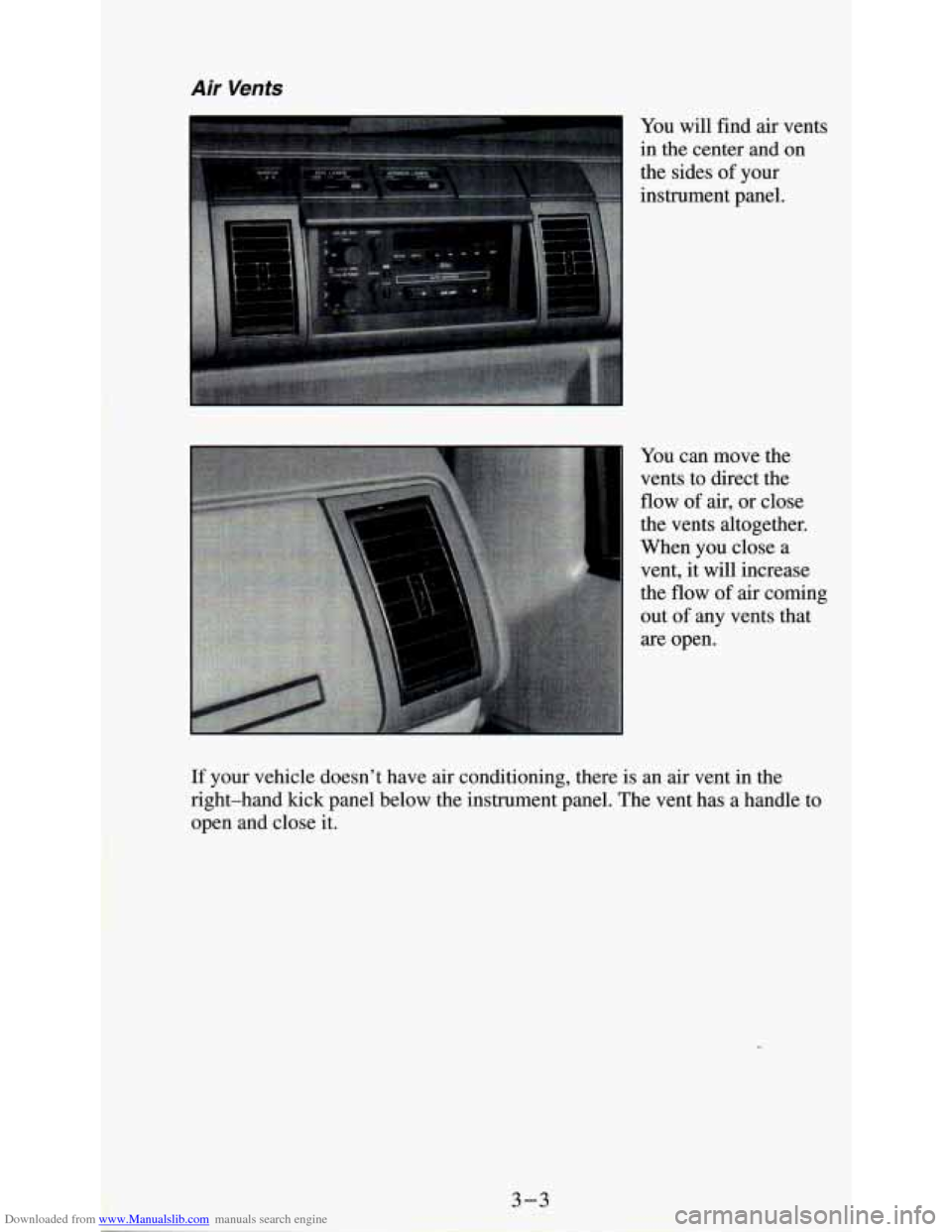
Downloaded from www.Manualslib.com manuals search engine Air Vents
I You will find air vents
in the center and on
the sides of your
instrument panel.
You can move the
vents to direct the
flow
of air, or close
the vents altogether.
When
you close a
vent, it will increase
the
flow of air corning
out of any vents that
are open.
If your vehicle doesn’t have air conditioning, there is an air vent in the
right-hand kick panel below the instrument panel. The vent has a handle to
open
and close it.
3-3
Page 132 of 340
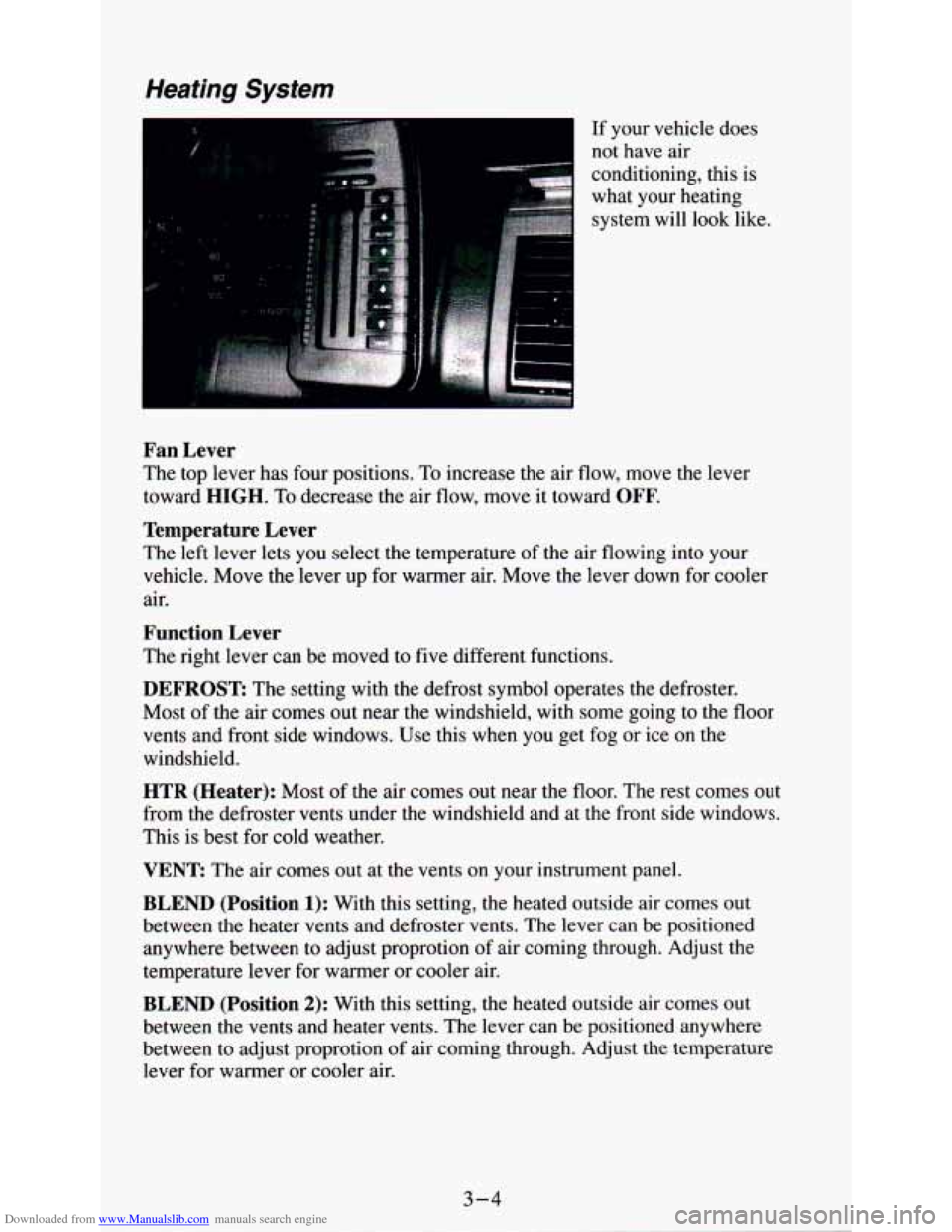
Downloaded from www.Manualslib.com manuals search engine Heating System
If your vehicle does
conditioning, this is
what your heating system will look like.
I not have air
Fan Lever
The top lever has four positions. To increase the air flow, move the lever
toward
HIGH. To decrease the air flow, move it toward OFF.
Temperature Lever
The left lever lets you select the temperature of the air flowing into your
vehicle. Move the lever up for warmer air. Move the lever down for cooler
air.
Function Lever
The right lever can be moved to five different functions.
DEFROST The setting with the defrost symbol operates the defroster.
Most of the air comes out near
the windshield, with some going to the floor
vents and front side windows. Use this when you get fog or ice on the
windshield.
HTR (Heater): Most of the air comes out near the floor. The rest comes out
from the defroster vents under the windshield and at
the front side windows.
This is best for cold weather.
VENT The air comes out at the vents on your instrument panel.
BLEND (Position 1): With this setting, the heated outside air comes out
between the heater vents and defroster vents. The lever can be positioned
anywhere between to adjust proprotion of air coming through. Adjust the
temperature lever for warmer or cooler air.
BLEND (Position 2): With this setting, the heated outside air comes out
between the vents and heater vents. The lever can be positioned anywhere
between to adjust proprotion of air coming through. Adjust the temperature
lever for warmer
or cooler air.
3-4
Page 133 of 340
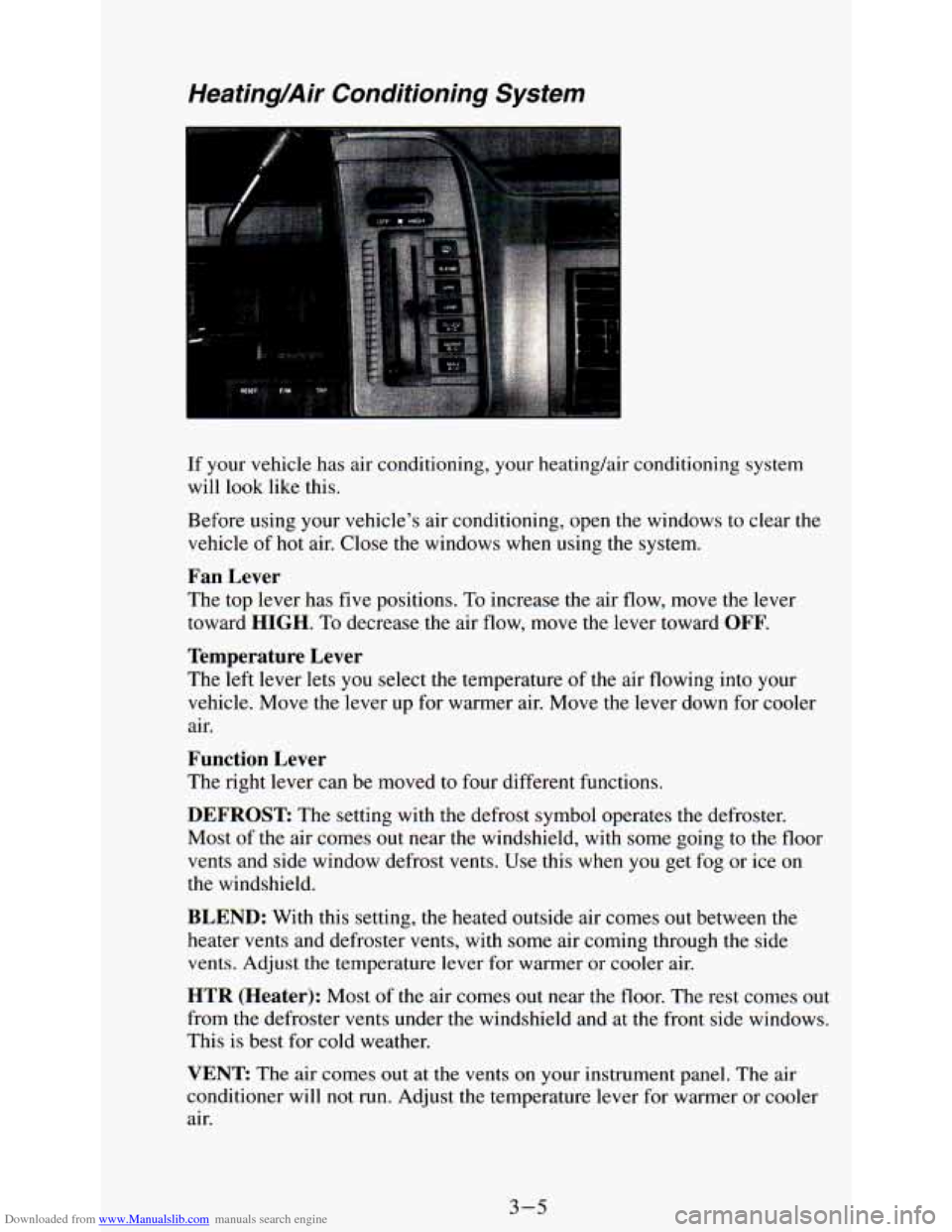
Downloaded from www.Manualslib.com manuals search engine Heating/Air Conditioning System
If your vehicle has air conditioning, your heating/air conditioning system
will look like this.
Before using your
vehicle's air conditioning, open the windows to clear the
vehicle of hot air. Close the windows when using the system.
Fan Lever
The top lever has five positions. To increase the air flow, move the lever
toward
HIGH. To decrease the air flow, move the lever toward OFF.
Temperature Lever
The left lever lets you select the temperature of the air flowing into your
vehicle. Move the lever up for warmer air. Move
the lever down for cooler
air.
Function Lever
The right lever can be moved to four different functions.
DEFROST The setting with the defrost symbol operates the defroster.
Most of the air comes out near the windshield, with some going to the floor
vents and side window defrost vents. Use this when you get fog or ice on
the windshield.
BLEND: With this setting, the heated outside air comes out between the
heater vents and defroster vents, with some air coming through the side
vents. Adjust the temperature lever for warmer or cooler air.
HTR (Heater): Most of the air comes out near the floor. The rest comes out
from the defroster vents under the windshield and at the front side windows.
This
is best for cold weather.
VENT: The air comes out at the vents on your instrument panel, The air
conditioner will not run. Adjust the temperature lever for warmer or cooler
air.
3-5
Page 134 of 340
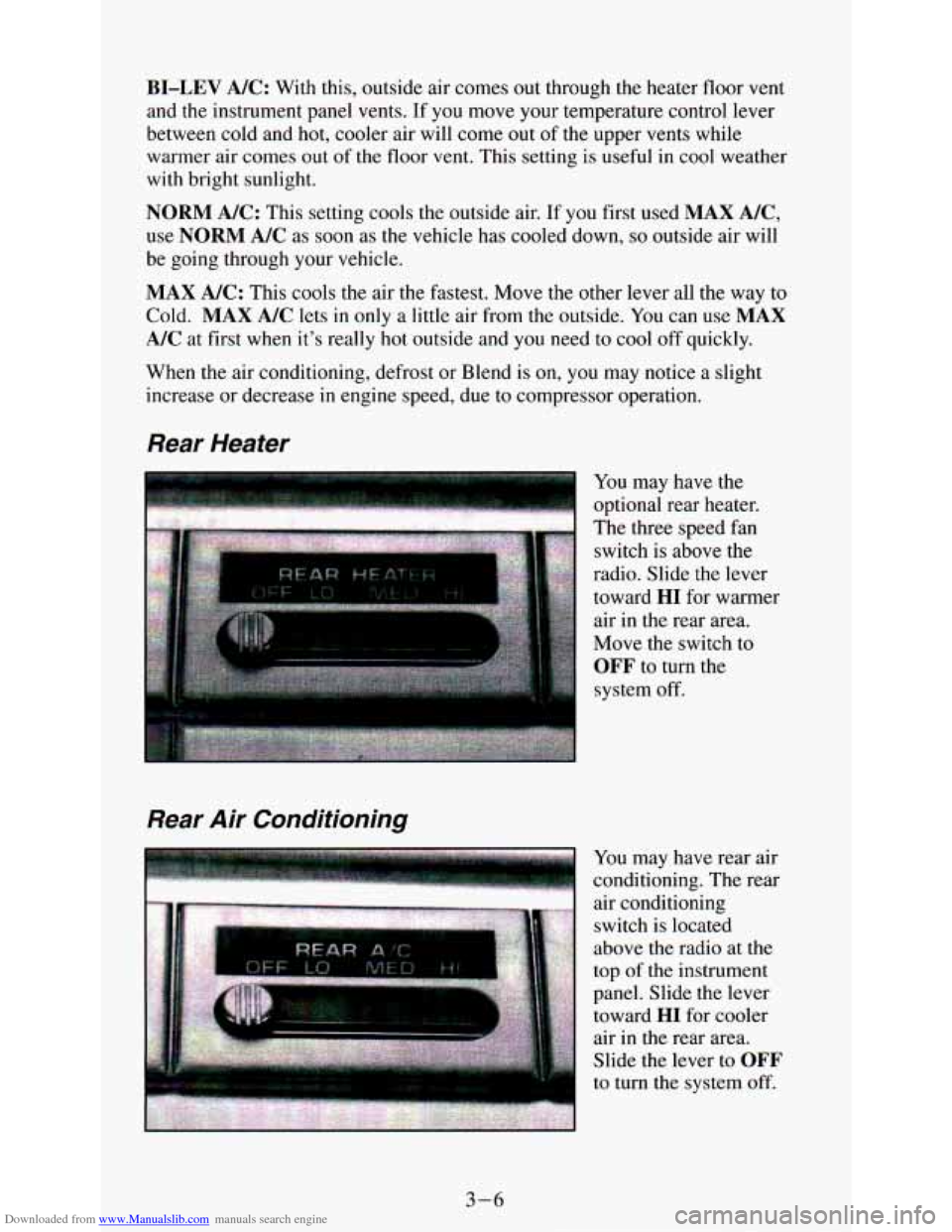
Downloaded from www.Manualslib.com manuals search engine BI-LEV A/C: With this, outside air comes out through the heater floor vent
and the instrument panel vents. If you move your temperature control lever
between cold and hot, cooler air will come out of the upper vents while
warmer air comes out of the floor vent. This setting is useful
in cool weather
with bright sunlight.
NORM A/C: This setting cools the outside air. If you first used MAX A/C,
use NORM A/C as soon as the vehicle has cooled down, so outside air will
be going through your vehicle.
MAX A/C: This cools the air the fastest. Move the other lever all the way to
Cold.
MAX A/C lets in only a little air from the outside. You can use MAX
A/C at first when it's really hot outside and you need to cool off quickly.
When the air conditioning, defrost or Blend is on, you
may notice a slight
increase or decrease
in engine speed, due to compressor operation.
Rear Heater
You may have the
optional rear heater.
The three speed fan
switch is above the
radio. Slide the lever
toward
HI for warmer
air in the rear area.
Move the switch to
OFF to turn the
system off.
Rear Air Conditioning
You may have rear air
conditioning. The rear
air conditioning
switch is located
above the radio at the
top
of the instrument
panel. Slide the lever
toward
HI for cooler
air
in the rear area.
Slide the lever to
OFF
to turn the system off.
3-6
Page 135 of 340
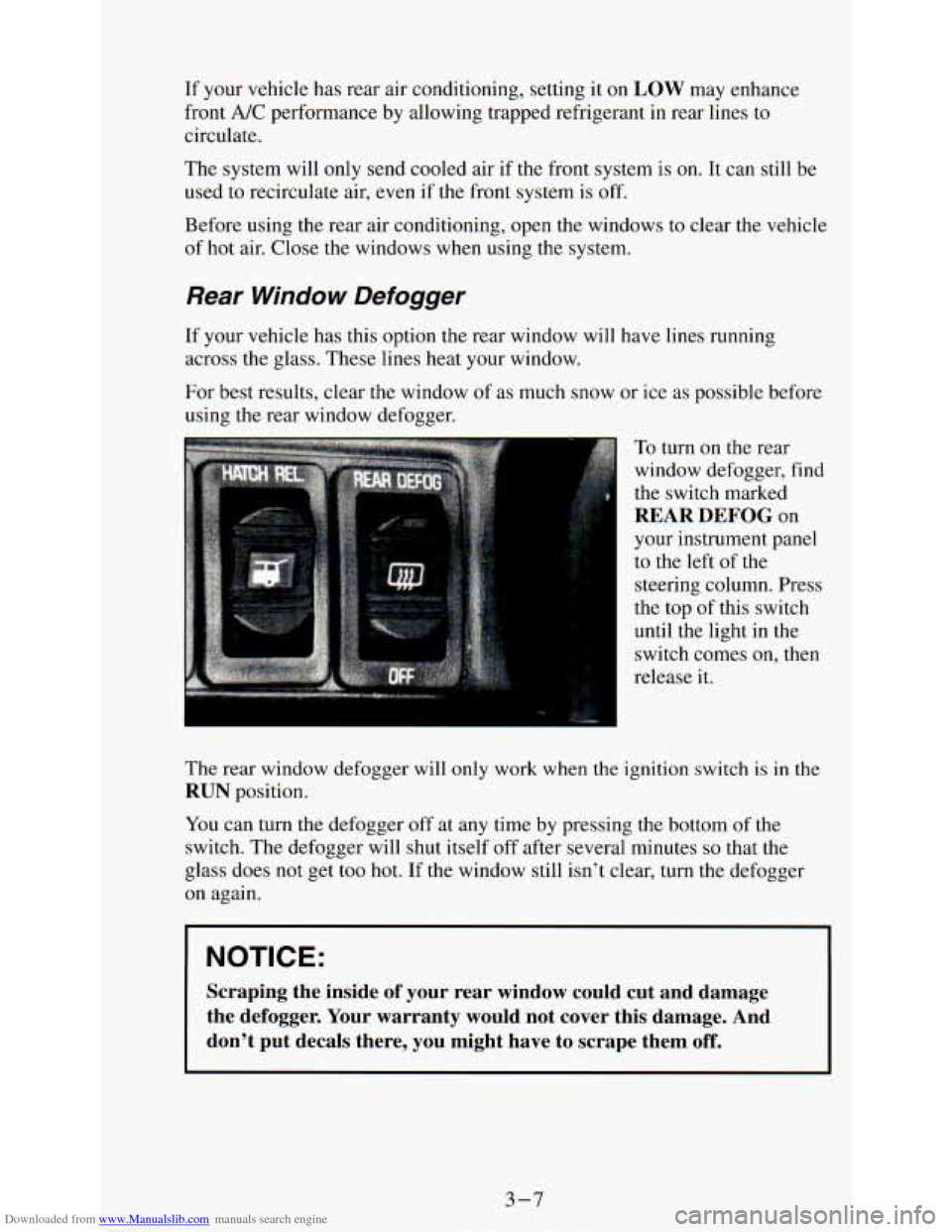
Downloaded from www.Manualslib.com manuals search engine If your vehicle has rear air conditioning, setting it on LOW may enhance
front A/C performance by allowing trapped refrigerant in rear lines to
circulate.
The system will only send cooled air if the front system is on. It can still be
used to recirculate air, even if the front system is off.
Before using the rear air conditioning, open the windows to clear the vehicle
of hot air. Close the windows when using the system.
Rear Window Defogger
If your vehicle has this option the rear window will have lines running
across the glass. These lines heat your window.
For best results, clear the window
of as much snow or ice as possible before
using the rear window defogger.
To turn on the rear
window defogger, find
the switch marked
REAR DEFOG on
your instrument panel
to the left
of the
steering column. Press
the top of this switch
until the light in the
switch comes on, then
release it.
The rear window defogger will only work when the ignition switch is in \
the
RUN position.
You can turn the defogger off at any time by pressing the bottom of the
switch. The defogger will shut itself off after several minutes
so that the
glass does not get too hot. If
the window still isn’t clear, turn the defogger
on again.
I NOTICE:
Scraping the inside of your rear window could cut and damage
the defogger. Your warranty would not cover this damage. And
don’t put decals there, you might have to scrape them
off.
I
3-7
Page 196 of 340
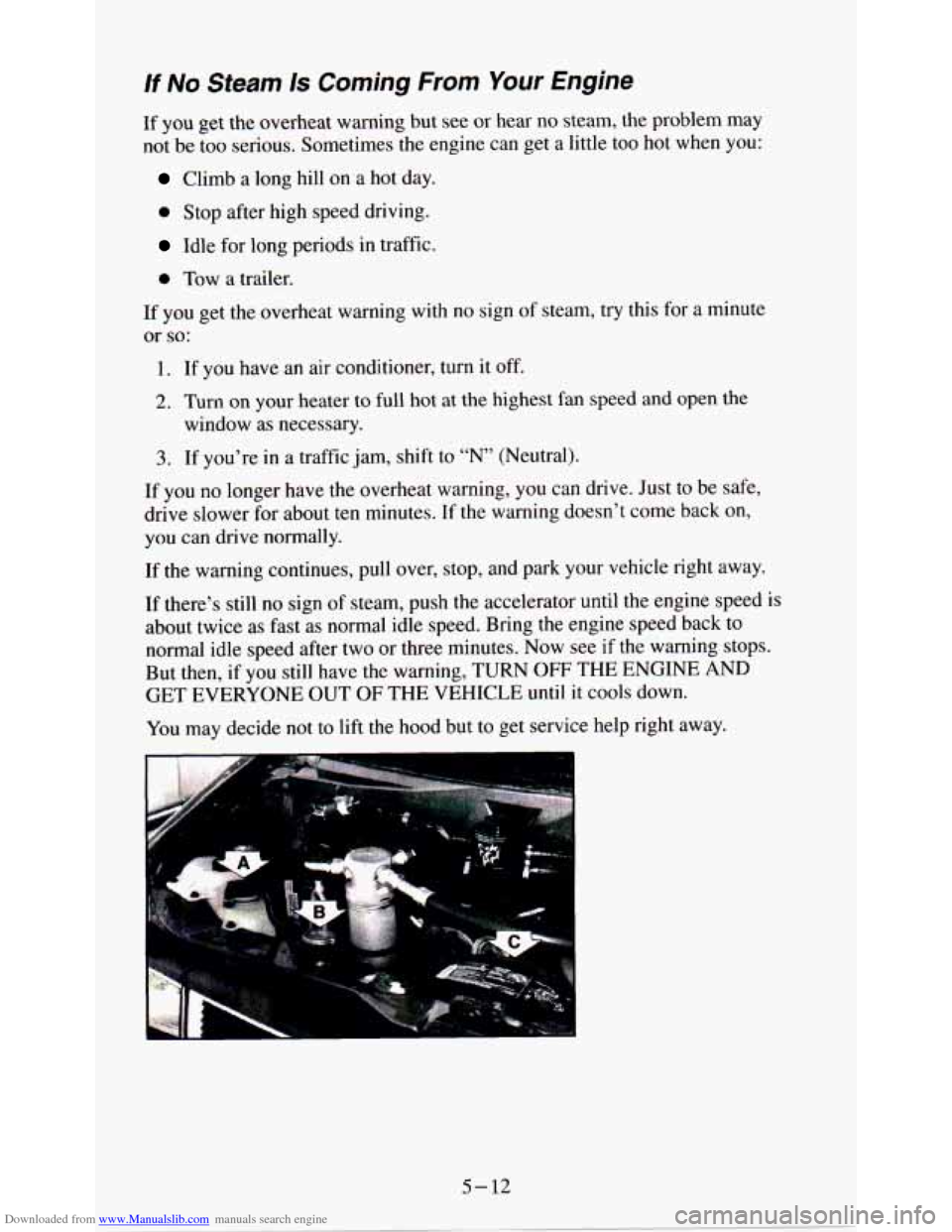
Downloaded from www.Manualslib.com manuals search engine If No Steam Is Coming From Your Engine
If you get the overheat warning but see or hear no steam, the problem may
not be too serious. Sometimes the engine can get a little
too hot when you:
Climb a long hill on a hot day.
0 Stop after high speed driving.
Idle for long periods in traffic.
0 Tow a trailer.
If you get the overheat warning
with no sign of steam, try this for a minute
or
so:
1. If you have an air conditioner, turn it off.
2. Turn on your heater to full hot at the highest fan speed and open the
3. If you’re in a traffic jam, shift to “N” (Neutral).
window as necessary.
If you no
longer have the overheat warning, you can drive. Just to be safe,
drive slower for about ten minutes.
If the warning doesn’t come back on,
you can drive normally.
If the warning continues, pull over, stop, and park your vehicle right away.
If there’s still
no sign of steam, push the accelerator until the engine speed is
about twice as fast as normal idle speed. Bring the engine speed back to
normal idle speed after two or three minutes. Now see if the warning stops.
But then, if you still have the warning, TURN
OFF THE ENGINE AND
GET EVERYONE OUT OF THE VEHICLE until it cools down.
You may decide not to lift the hood but to get service help right away.
5-12